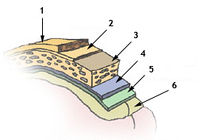Meninges - Anatomy & Physiology
Outer Layers
The central nervous system (CNS) is surrounded by several layers of tissue, with several outer layers not directly related to the CNS and three membranes that directly envelope the CNS. The outer layers are the skin and then a bone layer with associated periosteum. This layer includes the skull and the vertebrae. Below the periosteum is the Epidural Space which lies between periosteum and dura in the vertebral canal. The epidural space contains adipose tissue, loose connective tissue, veins and lymphatics. It cushions the cord as it flexes. The epidural space is regularly used for nerve blocks where a local anaesthetic such as Lidocaine is injected to block signal transmission to and from the spinal cord.
Dura mater
The Dura mater is the outer menix and is made up of a dense fibrous connective tissue. In the cranium, the dura layer is fused with the periosteum and therefore is in effect single layer without an epidural space. The dura contains a number of folds throughout it's coverage of the brain including the Falx cerebri, a midline fold between cerebral hemispheres, the Tentorium cerebelli, an oblique fold between the cerebrum and cerebellum and the Diaphragma sellae which forms a collar around the neck of the pituitary and forms the roof of the hypophyseal fossa. This layer and these associated folds all provide structural support to the brain and prevent the brain from undergoing excess movement within the skull. Where the dura mater folds between brain tissues it splits into two distinct layers that are seperated by large blood filled spaces called venous sinuses. Venous sinuses are directly connected to the venous system and venous blood from vessels supplying the brain return to the heart via these sinuses.
- Subdural space
- Lies between dura and arachnoid (not fused). Potential space containing only lymph-like fluid. Site of subdural hematoma.
- Arachnoid mater
- Delicate, non-vascular connective tissue
- Adhered to the skull in the calvaria.
- Subarachnoid space
- between arachnoid and pia connected by tiny filaments (spider-like)
- contains CSF from ventricular system
- largest parts are the cisterns
- Cerebellomedullary cistern around the foramen magnum. Used for the collection of CSF
- Lumbar cistern used for lumbar puncture in man
- Pia mater
- highly vascular connective tissue, very closely applied to brain tissue
- Subdural space
